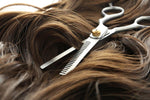

The thinning scissors appear similar to regular hair cutters however, they differ in the shape in the cutting blades. Thin scissors feature blades that are not an uninterrupted, straight blade, comprise the rows of tooth. The blades comprise teeth. The toothed structure will result in only a fraction part of hair getting cut.
Thinning scissors that hairdressers and hairstylists use typically have 30-40 teeth.
A 40-tooth evenly spaced standard thinning shear and a 5 tooth notcher could each cut off 35 percent of hair (i.e. you will have a cut percentage of 35%) however the result the other shear produces differs in comparison to the other.
The normal thinning shear is able to take off weight equally, while the five-tooth notcher significantly more of a broken result. The way the teeth of the metal are aligned will assist stylists decide whether the shear is suitable for the teeth.
Pick a type of thinning scissors specifically designed for the function. There are general-purpose scissors available however they will not always give you the desired outcome. The more teeth you have on your blades and the less hair is cut. To remove excess hair It is therefore recommended to select scissors with only a few teeth, as this will permit you to cut larger portions of hair. They are also great for creating more daring hairstyles.
A higher amount of teeth result in more fine quantities of hair being cut off per cut. If you're looking to remove small amounts you are thinning the end of your hair or bangs or mixing layers These scissors are a better option. The type of shears typically comes with two rows of teeth, so bear the double rows in your mind while selecting. Often, the packaging of the scissors lists an amount of percentage that indicates the amount of hair within a particular section will be removed on every pass.
A Difference In Thinning Scissors With Few Or Many Teeth
A shear that has thin teeth and small spaces between them can remove the weight in a manner that doesn't create an obvious bulk or texture. Both the cut and undamaged hair tends to mix. The typical shear has between 30 and 45 teeth, depending upon the size of blade. Thinning shears are ideal for smoothing out scissor marks to remove any sharpness from cuts.
In the past, nearly all shears for blending had two disadvantages. The first was that stylists needed use various methods to prevent them from cutting lines. Since the hair was fixed in place and then cut along the blade at the same spot it is possible to create cutting lines.
The cutting line can be observed. Then, if hairdressers would like to pull their hands back following the cut they would have to remove the blades and take care not to risk pulling the client's hair by pulling it along the sharp straight blade that is between the teeth.
What Scissors for Thinning I Should Purchase? How many teeth do I need?
A: Would I like buy a pair of thin scissors to thin some of the hair at the top of her hair. As I browse the internet, I find some with as little as 20 teeth, while some are as large as 45 teeth. Some have teeth on just one blade, while some are equipped with teeth that cover both blades.
There are advertisements for thin shears that include as much as 50 percent hair being removed , while other ads only show 15 percent. Please help me comprehend what I should be aware of to purchase the best shears for thinning.
It is typically the main issue that individuals face when looking at shears that are thin. The method they operate isn't intuitive. It is because the more teeth a pair thin shears have more teeth, the less hair is removed. However, the shears with less teeth, more wide and wider-spaced take out more hair and in larger chunks.
The percentages given in a description of a pair of thinning shears is an approximate proportion of hairs cut by closing the blades on a piece of hair.
The shears with 15 percent removal are going to remove approximately 15 percent from the hair between the blades with one snip. You can also get additional 15% increments using several cuts. Due to this even with less percentages you must ensure that you don't "overdo" it using the shears, or you could create some substantial hair removal.
Shears with higher teeth count are usually used to blend and eliminate the bulk of hairstyles, particularly for fine-to medium, straight-towavy hair kinds. This is probably the type of hairstyle you're looking for. I'd recommend the shears that take away around 15 percent from the hair per cut since it is possible to remove some more, but you won't be able to put it in after having cut.
The smaller-number/wider-teeth shears are meant for curly hair types as they can remove chunks of curl and leave the hair looking lighter and less bulky without making it so "diffuse". Utilizing these types of shears for straighter hair kinds will give an unnatural, gapped appearance and is usually not preferred.
Comments
-
So well explained, Jun! I’m no hairstylist but would love to make it a profession after discovering I actually enjoy cutting hair. I first started with wonky bangs on my older sister and then proceeded to a quick trim. Now I’m trying to learn how to cut perfect layers and how to use thinning scissors, especially on big, wavy hair.
Blog posts
